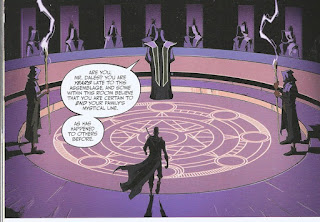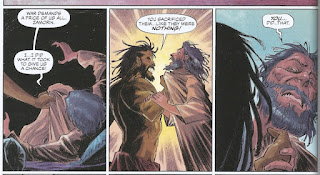Pick of the Brown Bag
May 8, 2019
Part One
by
Ray Tate
There was a glut of comic books to review and quite frankly the giant sized column would have been horrendous to read. So, I've broken it up into parts. For this chapter of the largest Pick of the Brown Bag I've ever written, I review the new books Bronze Age Boogie, The Decendent, Excellence, Eve Stranger and Gogor. I'll also look at These Savage Shores. As per usual, the Twitter feed will be up and running: #PickoftheBrownBag.
Brandon Thomas returns with co-creator Khary Randolph for Excellence. Excellence is a brew of Harry Potter, Jedi Knights, Guardian Angels and Isaac Asimov.
Obviously that last law is going to be nettlesome.
The story begins with a melange of privilege, position, parent and progeny. It’s the tale of a son and the expectations of his father. That they happen to be wizards is the spice.
All seems well in the life of the highly respected Brother Raymond Dales. Unfortunately his son is a late bloomer. That causes consternation and strife.
Brother Dales’ consistent lack of pride in his son leads to his ignoring the youth. Like Darth Vader, the boy—christened Spencer Raymond Dales—channels his anger into the mystical power that’s his birthright.
With this new development, Spencer submits himself to the Aegis. The Aegis is your basic circle of establishment, but what distinguishes Randolph’s and Thomas’ group is their mission statement and their determination to use magic anonymously.
The Aegis drops him into our reality, and a group of magical rivals follow to thwart him. Spence’s task consists of getting a man to devote himself to a woman.
Sounds easy. He’s going to propose. All Spence must do is give him a little push. Thaw the cold feet. At the same time he must outwit the hit squad.
What they don’t know is that Spence has an ace up his sleeve courtesy of his grandmother.
It’s important for Thomas and Randolph to include a quintessential female character in the story. Spence’s mother is also more than a match for Brother Dales. The fourth law the adepts follow after all is sexist. Perhaps based on the all male Catholic priesthood. In any case, a writer needs to distinguish between the sexist society of his fiction and his own real belief. Else you threaten to preclude a potential audience. Excellence is likely to evolve as Spencer continues his journey, and least one of those laws apt to be struck down.
Gogor by writer/artist Ken Garing appears to be a science fantasy. When student Armano sees the School of Natural Arts being attacked, he tries to defend his friends and teachers.
This leads off the beginning chase where right on page one, we discover a truly unique, vibrant world that’s only loosely based upon our own.
Armano’s world actually consists of a series of floating islands. I’m not going to spoil the impact of the imagery, which is breathtaking in execution and scope.
In time Armano meets a fellow traveler who helps him decipher the scroll his rector entrusted.
In many ways, Gogor is a mixture of genres. On the one hand you have blasters from science fiction. On the other hand, the opposition is riding giant ants, a scientific impossibility. Armano is clearly from the realm of magic and martial arts. Then we have the scene by the campfire which so often happens in the western. Finally, at the end of the story kaiju. Garing puts these parts together seamlessly in a visual narrative an inviting exotic and diverse cast.
In many ways, Gogor is a mixture of genres. On the one hand you have blasters from science fiction. On the other hand, the opposition is riding giant ants, a scientific impossibility. Armano is clearly from the realm of magic and martial arts. Then we have the scene by the campfire which so often happens in the western. Finally, at the end of the story kaiju. Garing puts these parts together seamlessly in a visual narrative an inviting exotic and diverse cast.
In the waning 1920s Charles Lindbergh piloted a single-engine plane from New York to Paris. The first continuous transatlantic flight brought him international fame. Lindbergh intended to recoup the laurels into a political career.
History had other ideas.
In 1932 somebody abducted the Lindbergh baby boy. The kidnapers later murdered the child. Authorities arrested Richard Hauptmann for the crime.
Despite the physical evidence, Hauptmann denied all charges. Though not as conspiracy rich as Jack the Ripper or the Kennedy assassination, the Lindbergh murder attracted its share.
In Descendent, writer Stephanie Phillips and artist Evgeniy Bornyakov introduce their story with a modern second kidnapping of a child that mirrors the Lindbergh baby abduction.
Carter Miller is a budding Nazi with aim for the White House. He and his young wife Jean have a son named Jack, and just like Lindbergh, they find a random note in the crib.
Phillips and Bornyakov make use of an obscure peculiarity in the Lindbergh note. The abductors included a symbol, whose meaning remains a mystery. Viewed in a certain way, it looks like an eye.
Descendent is the stuff of The X-Files. Phillips and Bornyakov have that area covered as well. Dr. Amanda Mansfield and David Corey are a far cry from Mulder and Scully, but they serve the general purpose. With David recognizing the symbol, and another kidnapping, cult and conspiracy activity seem in full swing.
The difference between Descendent and other conspiracy based media lies in the quality of the writing. Phillips ability is evident in the smoothness of the dialogue, and her ear of every day talk that livens possible dull scenes.
The conversation between the guards, ordinary but fun characterizes them neither as bad or good but every day Joes that are just doing their jobs. It’s this kind of writing that can be seen in characters outside of the threat zone that makes Descendent an overall strong, interesting read. Because ultimately its too early to tell about the whole Lindbergh thing. So the hook to Descendent is pure technique.
Eve Stranger is the name of David Barnett’s and Phillip Bond’s new protagonist. This is part Run Lola Run and part Bourne Identity. Eve wakes up in various places with no memory of her previous actions.
The approach and the bigger story differentiates Eve Stranger from its fictional precedents. Eve does things that a normal person would, like call the cops.
Without evidence, there’s not much the police can do. Although Eve’s world seems to stop and start. That’s not what happens externally. So, the people behind Eve build immunity. Eve’s continued attempts to draw attention fizzle, and she in turn looks like a harmless kook.
Eve though is far from harmless, and the proponents in no way benign. Eve’s current assignment should she decide to accept it is to free a senator’s son from a group of abductors, quite the theme this week.
Though I like to keep secrets, Barnett doesn't. He divulges the lion's share of Eve Stranger's makeup, and spins a subplot out of the Alias action so beautifully choreographed by Bond. And then there's what may be a bigger picture hinted at in the cartoony back up by artist Liz Prince.
That's right Eve Stranger could all be a sham. The larger than life story perfect for fiction just may be a fiction within a more mundane fiction. Eve Stranger could just be an ordinary small town reporter with vivid dreams and a wild imagination.
Normally, saying it's all been a dream is a cop out. This sort of plot resolution only worked on Newhart, but because Barnett foreshadows it as a possibility and adds another meta-layer, Eve Stranger succeeds.
Normally, saying it's all been a dream is a cop out. This sort of plot resolution only worked on Newhart, but because Barnett foreshadows it as a possibility and adds another meta-layer, Eve Stranger succeeds.
This issue transports Brita to the seventies where archetypes of the period film genre including a bad ass black woman Lynda Darrk fights Invading Martians.
The fight takes them into apartment of Jackson Li, martial arts master, of course.
It’s difficult to say what Bronze Age Boogie is about. My opinion so far is that it’s a series of loosely connected short stories thematically inspired by cult movies. Things happen fast in these stories and there’s little room for character development. Writer Stuart Moore instead relies on the reader to recognize Coffey and Bruce Lee nesting inside of Darrk and Jackson as he tosses them at a War of the Worlds situation. The stories are well crafted in the sense of touchstones and overall plot mechanics as well as How point a gets to point b. I like what I'm reading, but it's largely an echo and just as hollow.
These Savage Shores is the opposite of hollow. This is a vampire story but with remarkable originality that resonates with the writing of the old masters, such as Bram Stoker and Poe.
The story is set in India. In a previous issue, we meet Alain Pierrenfont. Alain was a vampire. Emphasis on the was. He met his demise not at the hands of a vampire hunter who followed him but Bishan.
Bishan is a guardian, a near deity who can change his shape at will. He protects the young Prince as he loves Royal house member Kori. These are poor definitions for the well-researched work. I'm just breaking it down into digestible frameworks. The truth is that Kori is much more than handmaid. Bishan is much more than mystical guardsman. The vampires are more than just vampires as is the hunter.
The art by Sumit Kumar adds a rich, layered texture to Ram V's words. If this were just a prose tale, the description would fill books upon books. These depictions as well seem like the works of old.
The story is set in India. In a previous issue, we meet Alain Pierrenfont. Alain was a vampire. Emphasis on the was. He met his demise not at the hands of a vampire hunter who followed him but Bishan.
Bishan is a guardian, a near deity who can change his shape at will. He protects the young Prince as he loves Royal house member Kori. These are poor definitions for the well-researched work. I'm just breaking it down into digestible frameworks. The truth is that Kori is much more than handmaid. Bishan is much more than mystical guardsman. The vampires are more than just vampires as is the hunter.
The art by Sumit Kumar adds a rich, layered texture to Ram V's words. If this were just a prose tale, the description would fill books upon books. These depictions as well seem like the works of old.






























No comments:
Post a Comment